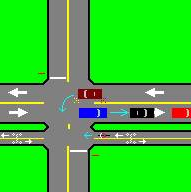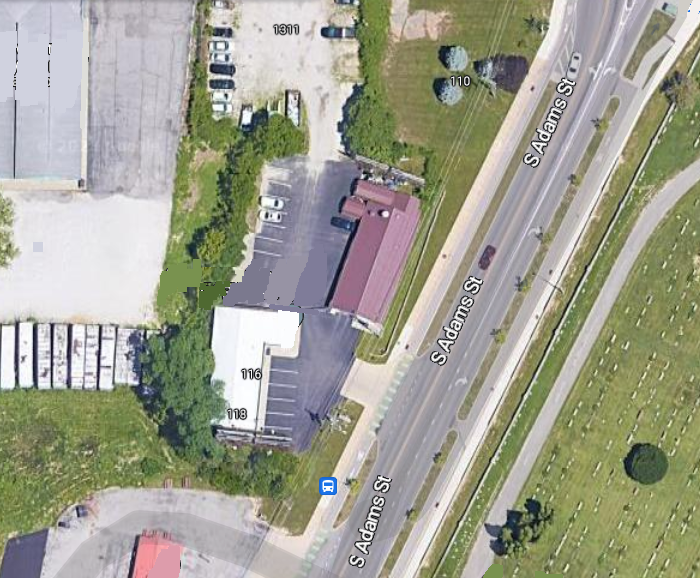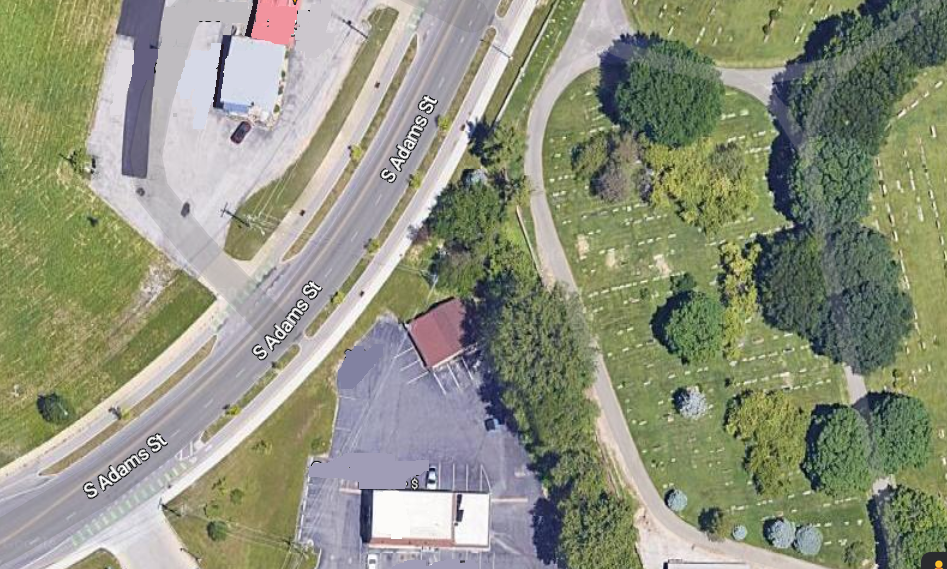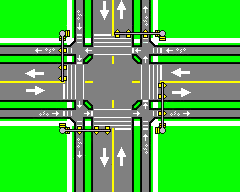THE TERRIBLE 7-LINE
IN BLOOMINGTON INDIANA

B-Line Trail Morton
College

College
Walnut
Washington

Washington
Lincoln
Grimes

Grimes
Dunn

Indiana
Fess
Park

Park
Woodlawn
The 7-Line was built on Seventh Street between the B-line trail (near Morton Street) and
Woodlawn Avenue. It was the liberal ideal of what a complete street for cars, bicycles, and
pedestrians should be like.
This was supposed to be the bicyclist's ideal: a bikeway where the rider does not have to stop
for other traffic for most if its length. Only at the traffic signals at College and Walnut did
the cyclist have to stop.
Now they want to build another of these monstrosities on Second Street.
HAZARDOUS TRAFFIC CONTROL
HOW WRONG COULD THEY BE?
The city stupidly built a two-way bikeway along the south edge of Seventh Street. This caused the
following problems:
- Notice the divider strips between the auto lanes and the bicycle lanes on the south side of the
street. Traffic flows in both direction on each side of the divider.
- Conflicts exist where the conflicting vehicle is going the same direction on the other side of the
divider. The drivers of these might not see each other even though their paths might cross.
- A standard 4-way intersection with 2-way 2-lane streets has 12 movements and 16 crossing
conflicts. The intersections with two-way cross streets on the 7-Line have 24 movements and 64
crossing conflicts. That's way too many. See below.
- Too many conflicts are grouped together into a very tight space,
- Transit buses and other long vehicles (including fire engines) could not make the turns at the
intersections.
- Moving vans parked in the bike lanes because the movers would not carry heavy furniture across
the divider.
- Approaching bicycles are in the blind zones of drivers coming from the same direction.
- Side street traffic has to scan 4 different streams of cross traffic to cross safely.
- If traffic is heavy, side street traffic has little chance of crossing.
- Before the 7-Line was built, the intersection of 7th and Dunn had an average of one accident
per year. The rate after the 7-Line opened averages 12 accidents per year.
- The city engineer put an all-way (is it 4-way or 6-way) stop at 7th and Dunn.
- Other intersections on the 7-Line also had accident frequency increases after the 7-Line opened.
City officials are quibbling about what to do with them.
- The 7-Line is no longer the bicyclist's ideal. Bicycles now have to stop.
- The city originally put the bikeway on one side of the street to save money.
- The City Engineer wants more all-way stops on the 7-Line.
The traffic commission and the city council want the 7-Line restored to no stops for bicycles.
Technical and safety people want the stop signs, political people want them removed to please
cyclists.
This design causes hidden conflicts where two drivers cannot see the other until it is too late.
The 7-Line looks like it was designed by an idiot cyclist with the belief that bicycles should never have
to stop.
REASONS WHY THESE PRACTICES ARE SO DANGEROUS:
THE FIVE RULES OF RIGHT-OF-WAY:
We learned the Five Rules of Right-of-Way when we learned to drive. They are:
- The vehicle arriving first at the intersection gets to go first.
- If two vehicles arrive simultaneously, the vehicle on the right goes first.
- Left-turning vehicles yield to oncoming traffic.
- Yield to vehicles and pedestrians already in the intersection.
- Turning vehicles yield to pedestrians.
Traffic control devices can supersede some of these rules by assigning right-of-way.
THE FIVE RULES OF RIGHT-OF-WAY DON'T WORK ALONE TO ASSIGN RIGHT-OF-WAY ON THE 7-LINE.
Traffic comes from unexpected directions:
- Oncoming traffic using a lane to the right of the driver's lane.
- Conflicting traffic coming from behind the driver on either side.
- Cross traffic coming in four streams of alternating direction.
Failure of the Five Rules of Right-of-Way to handle all of the movements here causes the extra
accidents.
HOW APPROACHING VEHICLES ARE NOT VISIBLE FROM OTHER APPROACHING VEHICLES:
 Refer to the diagram at right and the blue arrows.
Refer to the diagram at right and the blue arrows.
- The maroon car wants to turn left across the bike lane.
- The bicycle is about to cross the intersection going straight ahead.
- The blue truck is blocking the driver of the maroon car's vision so he can't see the cyclist.
- The blue truck is also blocking the bicycle rider's vision so he can't see the maroon car.
- When the blue truck gets out of the way, the maroon car turns left into the path of the bicycle.
- The bicycle and the maroon car could collide.
This can also happen if the blue truck is not there, because each vehicle is in the other vehicle's
blind zone
There are at least 6 different combinations of bicycle and car movements that can cause this kind of
hazard.
OTHER FACTORS THAT AGRAVATE THE DANGER:
Here are other factors that make the danger worse.
- Trees planted in the divider strips hide bicycles, vehicles and pedestrians from each other.
- A bicycle on the left side of a street moving in your direction is not coming from an expected direction,
and may not be seen by drivers.
- A bicycle approaching from straight ahead on the right side of a street is not coming from an expected
direction, and may not be seen by drivers.
- Bicycles, unlike pedestrians, move too fast to be scanned for like drivers scan for pedestrians.
Notice that all of the wrong ways of building bicycle lanes and sidepaths create unexpected conflicts, bring
vehicles in from unexpected directions, or hide various traffic movements from each other. These dangers must
be avoided.
None of these wrong ways of adding bicycle lanes or paths conforms to the normal laws governing lane use
and right-of-way.
None of these wrong ways of adding bicycle lanes or paths conforms to the Manual of Uniform Traffic Control
Devices.

Adams Street

Adams Street

Complete Streets Intersection
HOW TO DO IT RIGHT:
WHAT NOT TO DO:
- Never put both lanes of a bikeway on the same side of a two-way street.
- Never have bicycles in a lane next to an auto lane moving in the opposite direction.
- Never have auto and bicycle traffic cross each other at nearly head-on angles (seen at Woodlawn in the
case above).
- Don't have vehicles coming from unexpected directions.
- Do not block cross traffic so much that it has trouble crossing the bikeway/street.
- Never make one class of vehicle yield to another at a merge.
 Make vehicles take alternating turns at a merge.
Make vehicles take alternating turns at a merge.
Taking turns makes the merge pass more traffic.
This is done wherever the separated bike lane ends.- Prohibit passing other vehicles just before intersections and merges.
- Never favor one kind of traffic at the expense of another.
A GOOD EXAMPLE:
These separated bike lanes are on Adams Street between Kirkwood Avenue and Third Street. It is the
correct way to add separated bike lanes to a street.
- Notice the divider strips between the auto lanes and the bicycle lanes on both sides of the street.
- Notice that bicycles travel in the same direction as the autos in the adjacent lanes.
- Notice that the bicycles are coming from expected directions. They are the same directions bicycles come
from on a normal street.
- Note that no lane with traffic flowing in the opposite direction is between two lanes going the same
direction.
 Make vehicles take alternating turns at a merge.
Make vehicles take alternating turns at a merge.
Taking turns makes the merge pass more traffic.
This is done wherever the separated bike lane ends.- Prohibit passing other vehicles just before intersections and merges.
- Control turns separately at traffic signals or use staged turns.
USE THE CORRECT COMPLETE STREETS INTERSECTION:
- Note that motor vehicles, bicycles, and pedestrian all go at the same time on the same street.
- Turning vehicles yield to other vehicles and pedestrians.
- Bicycles use staged left turns, first crossing the street on the right, and then when the light changes,
crossing the street in front.
- Left turn vehicle lanes, signals, and phases can be added. Permissive turn phases should not be used.
- Driveways can intersect the Complete Street design, provided they are not too close to intersections.
 Make vehicles take alternating turns at a merge.
Make vehicles take alternating turns at a merge.
Taking turns makes the merge pass more traffic.
This is done wherever the separated bike lane ends.- Prohibit passing other vehicles just before intersections and merges.
- Never stay to the left or right of another vehicle. Always leave empty space to the sides of your
vehicle.
Beauty is fitness expressed:
- The 7-Line looks awful from the driver's seat and from the air.
- It also does not work very well.
- But the Adams Street installation and the Complete Street look very nice.
- They also work well.
WHY IS THE 7-LINE SO HARD TO DRIVE SAFELY?
The standard overlap-or-conflict table that every driver uses for every normal intersection he encounters DOES
NOT WORK with the intersections on the 7-Line. A new table with 4 alternating movements is needed.
Most drivers do not have this expanded table, and many do not see how many movements are in a 7-Line intersection.
At a traffic signal, there is little trouble. But the driver needs to know that the bikeway is two-way.
At an all-way stop, there is little trouble. But the driver needs to know that the bikeway is two-way.
At an intersection where only one street stops, the new table is essential, as is knowing that the bikeway is
two-way.
USE 4-WAY INTERSECTION - SINGLE APPROACH TABLE
IN A TRICK TO DRIVE THE 7-LINE 6-WAY INTERSECTION
The trick is to mentally cut the intersection in two with the bikeway on one side and the motorcarway on the
other.
This trick requires the driver's brain to be able to allow a process to use (call) itself with different
information.
- The intersection directly ahead of the driver is the first intersection and the first overlap table use.
- The overlap table determines when the driver can go.
- To determine right-of-way, the leg of the first intersection connected to the second intersection must be
tested.
- To test that leg, the second overlap table use tests for traffic approaching the first intersection.
- The right-of-way through the first intersection is tested until it is granted.
- If the driver intends to cross the second intersection, the second overlap table use determines when the driver
can go.
- When all tests allow the driver to go, the driver can drive through the intersection.
The 4-way intersection single approach table is discussed above.
The 6-way 7-Line intersection is still difficult to drive. These tricks make it a little easier.






 Refer to the diagram at right and the blue arrows.
Refer to the diagram at right and the blue arrows.


 Make vehicles take alternating turns at a merge.
Make vehicles take alternating turns at a merge.

















 Means that the two movements diverge.
Means that the two movements diverge.